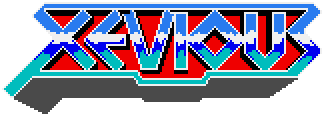

ARCADE EMULATION
06/20/97 ![]()
Emulator News
A new version of my Xevious Emulator is finished. Here are the features of v1.6:
![]() Support for SUPER XEVIOUS roms
Support for SUPER XEVIOUS roms 
![]() Sound support for PC-Speaker if no OPL2/OPL3 chip
is detected
Sound support for PC-Speaker if no OPL2/OPL3 chip
is detected
![]() Selectable gameplay (Difficulty Level) and number
of lives
Selectable gameplay (Difficulty Level) and number
of lives
![]() Frameskip option to gain emulation speed on slower
systems (486DX4/100 or Pentium 75)
Frameskip option to gain emulation speed on slower
systems (486DX4/100 or Pentium 75)
![]() Optional VGA mode with scanlines (useful on Notebooks)
Optional VGA mode with scanlines (useful on Notebooks)
![]() Selectable VGA pixelclock
Selectable VGA pixelclock
![]() Bugfixes
Bugfixes
Click here for a downloadable DEMO.
03/24/97
Emulator News
FINALLY: V1.3 of my Xevious emulator is released. All 3 Z80 processors are now up and running.
New features:
![]() SOUND support (OPL2/OPL3 compatible sound card required)
SOUND support (OPL2/OPL3 compatible sound card required)
![]() Joystick/Joypad support
Joystick/Joypad support
![]() High Score
saving
High Score
saving
![]() more code optimization
for gaining speed
more code optimization
for gaining speed
![]() some minor bugs
fixed
some minor bugs
fixed
At this place I would like to thank all the guys around the globe for registering my product.
02/27/97
Emulator News
XEVIOUS Emulator v1.0 Demo is now available. Please read the included README.TXT for detailed product information.
Please remember:
THE ORIGINAL XEVIOUS ROM IMAGES ARE NOT INCLUDED AND ARE NOT DISTRIBUTED ON THIS WEB PAGE
02/21/97
Emulator News
The Sprite Generator Emulation is running at last. The Xevious Sprite generator can handle up to 64 Sprites at the same time on the screen. Sprite size is 16x16, 32x16 (Rotating Shields) or 32x32 pixels (Explosions, Bunkers, Andor Genesis,...).
The biggest Sprite, the Andor Genesis Mothership, is build up from ten 32x32 Sprites (96x96 pixels).
My Emulator is now in a so called "RELEASE CANDIDATE" state:
![]() Multi-Z80 Xevious Arcade Emulation
Multi-Z80 Xevious Arcade Emulation
![]() Fully
playable (1 or 2 Players)
Fully
playable (1 or 2 Players)
![]() Original Arcade Colors
Original Arcade Colors
![]() Original Arcade Speed up from Pentium100
Original Arcade Speed up from Pentium100
![]() Arcade Screen mode 224x288
Arcade Screen mode 224x288
Things to be done:
![]() Sound
support
Sound
support
![]() Joystick/Joypad support
Joystick/Joypad support
![]() Code
optimising
Code
optimising
![]() Original Vertical Screen Mode
Original Vertical Screen Mode
ORIGINAL SCREENSHOOTS FROM THE EMULATOR
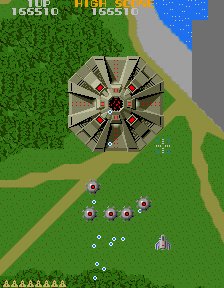





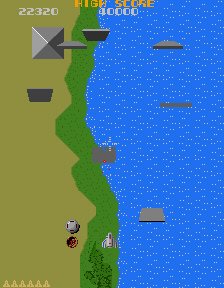



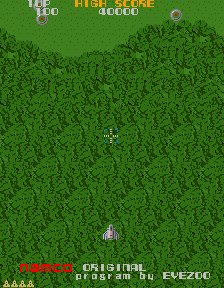
02/07/97
Emulator News
Now the 2nd Z80 processor is running. This 2nd CPU executes all the video related routines (Sprite handling, Background scrolling,...)
Also the emulation for the hardware-part ( one PAL, two custom chips, 2 ROM's and 3 EPROM's) of the background scrolling is running. I think this was the hardest part of the emulator.
During my work on my Xevious Emulator I did figure out some interesting things.
DIP-Switch 8 at position 10B has a very interesting function. In the manual it is written to leave this switch in the OFF position.
Here are the differences between OFF and ON:
OFF - Copyright message ATARI/NAMCO, High-Score Names are 3 characters long
ON - Copyright message NAMCO only, High-Score Names are 10 characters long
P.S.: When you change this switch during game from OFF to ON or vice-versa, then the game FREEZE !!!! (This is great for Screen-shoots).
HIGH-SCORE NAMES:
"M.Nakamura" (Masaya NAKAMURA) is a president's name of Namco.
"Evezoo End" (Masanobu ENDOH) was a game designer and programmer of XEVIOUS. Mr.ENDOH has left namco and founded his own company 10 years ago.
"S.Okamoto" (Shin-ichiro OKAMOTO) is a planner. He is namco's staff.
"S.Kojima" (Shin-ichi KOJIMA) is also a staff of namco. But I don't know how he was related to XEVIOUS.
"Eirry Mou.". I don't know him. It is maybe a nickname of namco's staff.
01/28/97
Version 0.1 of my Xevious Emulator has finished. It is not yet playable, but I think it looks promising. Look at the Screen-Shoot directly captured from my Emulator.
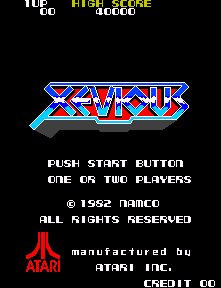
You will need also the "DOS32" protected mode DOS extender (included in the archive)..
My Emulator uses a "Tweaked" VGA mode (376x308 pixels). If you have problems with this screen resolution, please E-mail me !!!
I still need INFORMATION !!! about some Atari Custom Chips:
Custom 06xx (CPU-PCB Loc.6D) - Controller / Decoder
Custom 51xx (CPU-PCB Loc.6H) - I/O Controller
Custom 50xx (CPU-PCB Loc.6C) - Sound Sequencer
Custom 54xx (CPU-PCB Loc.6A) - 3-channel multiplexer
In fact that the hardware of Xevious is very similar to Galaga and Dig-Dug, this two great arcade classics are my next goals.
12/19/96
Currently I´m working on an Arcade Emulation for XEVIOUS. My Emulator will be written in 100% Assembler.
The original Xevious Arcade machine from Atari/Namco uses 3 Z80 processors. One for the main program, one for the graphics engine and one for the sound engine.
At the moment I´m working on emulating the background scrolling and the sound. I have successfully decoded the background graphics and the character sets from the original Xevious ROMs.
I´m still waiting for reicieving a package from US, including my long awaited Xevious PCB Without this PCB, it´s very hard to write an emulator.
In the meantime you can take a look on the character sets and the background playfield graphics.
CREDITS
My special thanks goes to:
* Ishmair (TM) for his excellent Z80 emulation engine (100% assembler :)
* Wilfried Weinzerl for selling me the book "Programming of the Z80" by Rodney Zaks.
* Franklin & Mary-Beth Bowens for sending me the COMPLETE manual and schematics of XEVIOUS
* Bill Esquivel for selling me an original XEVIOUS PCB-set (without the hardware I would be impossible to get all neccessary hardware information)
* Marc Incley for his excellent Z80 disassembler DZ80
Please send comments and suggestions to hr@elbatex.via.at or 100445.402@compuserve.com
|
|
This is the decoded background information. The complete background playfield is 1024 pixels wide and 2048 pixels high. The visible (scrolling) screen windows is 224 pixels wide and 288 pixels high. On the upper left side you can see the big bird.
The yellow area in the middle is the water section. The vertical green and blue lines are the streets. The sections on the upper and lower edges are the woods. |
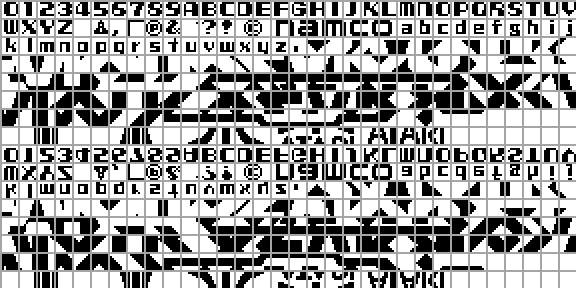
This is the character set for Text and Title Graphics

This is the character set for the background graphics

This is the first block of Sprite Data (64 Sprites)
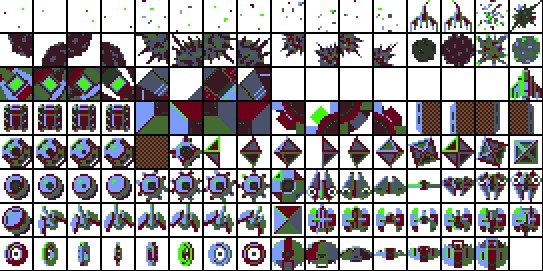
This is the 2nd block of Sprite Data (128 Sprites)
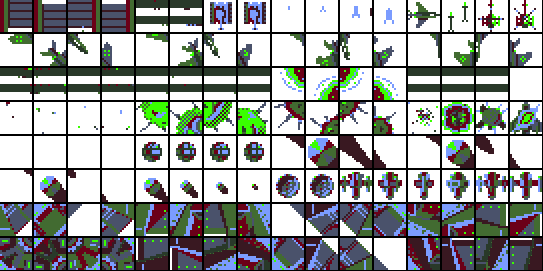
This is the 3rd block of Sprite Data (128 Sprites)